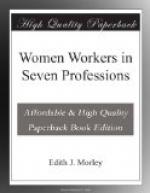It would not be surprising if all women who have incurred the heavy expenses of preparation for a teaching career, were dissatisfied with the very small return they may expect by way of salary. Certainly if we judged by the standard of payment, the profession might well appear unimportant. Men and women alike receive inadequate remuneration in all its branches, but, as in other callings, women are worse paid than men. One might imagine that the training of girls was less arduous or less important than that of boys, since no one suggests that women teachers are less conscientious or less competent than their male colleagues. Now that at every stage co-education of the sexes is becoming less unusual, it is wise policy in the interests of men as well as of women, to make the standard of remuneration depend, not on the sex of the worker, but on the quality of the work. Otherwise men will gradually be driven from the profession, as is already the tendency in the United States of America and, to some extent, in elementary teaching in this country. Needless to say, the women’s salaries need levelling up: it would be hopeless policy to reduce the men’s maxima to those of the women. In many secondary schools and in at any rate some elementary ones, there is too great a discrepancy between the salary of the head and that of the assistants. Here again, teachers might endeavour to arrive at some united expression of opinion. All would probably agree that the profession should be entered for the sake of the work itself, and not on the remote chance of becoming a head-mistress. But while the difference in salary is very great, it is inevitable that ambitious teachers must aspire to headships, even though they be better suited to class work.
Finally, it may be repeated, that with all its drawbacks, the teaching profession has much to recommend it to those who desire to make it their life-work. It is not suited to all comers: it makes heavy demands on mind and body and heart; it gives little material return. But it gives other returns in generous measure. For teachers it is less difficult than for most people to preserve their faith in human nature, less impossible, even in the midst of daily routine, to believe in the dignity of labour, and to illuminate it with the light of enthusiasm and aspiration.
“... whether we be young or old Our destiny, our being’s heart and home, Is with infinitude, and only there; With hope it is, hope that can never die, Effort, and expectation and desire, And something evermore about to be.”
[Footnote 1: The ideal inspector is, of course, a help and not a hindrance to the teacher, acting as a propagator of new ideas and bringing into touch with one another, workers who are widely separated. But the reach of most inspectors far exceeds their grasp.]
[Footnote 2: See table at end of section, p. 82.]




